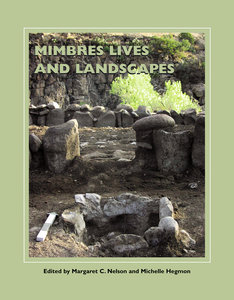Michele Hegmon of Arizona State University asked us to consider the Classic Mimbres society as "Another Way of Being," and to do so through the archaeological data. She began by contrasting the layouts of Mibres pueblos vs. contemporary structures at Mesa Verde.
Mesa Verde unit pueblos are very uniform in their overall form, and in room size and shape: Room block, kiva, midden. This is suggestive of lower autonomy, greater hierarchy (because someone is dictating the apparent standards).
Classic Mimbres: Less planning to pueblo layout, variation in arrangement and room size, and each household seems to be self-sufficient (every household shows evidence of processing areas and food preparation). In this type of community, social stability and progress depends on peer pressure to conform (example Classic Mimbres villages: Avilas Canyon, Flying Fish).
Hegmon also addressed conformity vs. standing apart. It has been fairly easy to establish a chronology of pottery styles for the Mimbres precisely because of a consistent conformity of style within each period, and then someone stretched the rules and moved to a new design. Mimbres pottery designs are a visual component of a shared culture, where conformity is the norm and is maintained through peer pressure, not hierarchical rule.
Hegmon also notes that there is little or no evidence of hierarchy in Mimbres burials.
She closes by wondering: "Why should modern culture care about the Classic Mimbres?" To understand that there are other ways of being... not better or worse ways, just other ways.
Karen Gust Schollmeyer from Simon Frasier University and Arizona State University presented her findings regarding deer hunting by the Mimbres.
She developed an excellent model for the deer population in the Mimbres area. She simulated hunting effects on the deer, and found that if hunting removed 18% or less of the deer each year, the deer population can remain steady. Middle Mimbres populations reached a demand level (222g, or 2 "deer burgers" per week per person) that exceeded 18%. If she runs the simulation with 26% hunting, the deer population crashes. Even if the hunting drops to 13% after 5 years, the deer never fully recover, instead continuing on a slower decline.
Do archaeological data support this? Dietary stress indicators are present in the record (in the form of evidence for breaking the deer bones to get marrow) that correlate with the same period when Mimbres populations were highest.
An interesting side note: isotope analysis of deer bones from that period show that some of the deer were eating higher amounts of C4 plants (maize is a C4 plant) than deer from earlier times. Were they eating maize grown by the Mimbres?
Margaret Nelson from Arizona State University (hmm... there's a trend here) gave a talk she titled Mibres Archaeology: Then and Now. Diversity was the theme.
- Diversity of ceramics styles varies inversely with population size for Mimbres.
- When is diversity good or bad?
- She found in the southwest that with the exception of Zuni, ceramic style diversity varies inversely with relative population density. (Paper out for publication on this)
- Also: Low ceramic style diversity is associated with (actually, is seen immediately prior to) major cultural transformations.
- What are the contexts that promote homogeneity, and what are the consequences?
In closing: The KIND of diversity we promote is as important as the simple valuing of diversity.

 While attending the
While attending the 